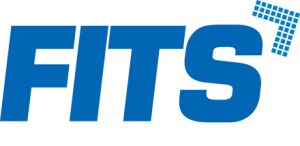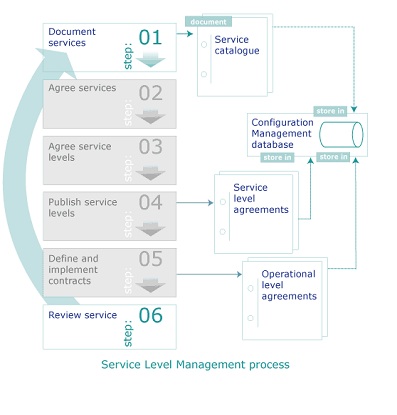
Module 7: Strategic Processes
What is Service Level Management?
Service level management is the process of ensuring that ICT services are supported to an acceptable level. It involves understanding the ICT requirements of the end-users and working within the constraints of the resources available to agree a level of service that end-users can expect consistently. This agreement is between those responsible for ICT and the end-users, who are usually represented by one or more people from each unique area or department.
When the services themselves and the level of service to be provided have been agreed, the service level management process facilitates the creation of underpinning agreements with other departments or third parties involved in the service provision.
It is important to understand the difference between services and levels of service:
Services
Services are the ICT facilities themselves, such as printing, bookkeeping, word processing, data storage, internet access, email, and so on.
Levels of service
Levels of service are the availability and maintenance of those services and the speed of response to incidents and requests. You could offer, for example, email availability from 0800 to 1800 Monday to Friday with a four-hour response time to resolve an incident and a two-day response time for a new account set up.
Why use Service Level Management??
Service Level Management helps to ensure that ICT services delivered to the end-users meets their needs. Some of the benefits of Service Level Management include that it:
- highlights what services are already in place
- helps to determine priority services
- indicates a clear remit for those providing technical support
- helps to allocate resources appropriately
- determines a minimum level of service that is acceptable
- helps to highlight shortcomings in service provision
- provides a basis for discussion and promotes communication
- provides targets to aim for
- helps to promote continuous improvement
Who uses Service Level Management?
Service level management is the bridge between ICT technical support and end-users. It is the mechanism that facilitates communication between the customer and those responsible for the service.
Service level management is the responsibility of ICT management, but by user representatives and suppliers participate in it, too. You should retain control of the ICT service even a third-party provides it. You can do this by using service level management to monitor and review the level of service your suppliers provide.
How Service Level Management works
Service Level management works by agreeing with end-users what services will be supported and to what level of service each will be supported. You then monitor these levels to give an indication of the suitability of the service provided and highlight any issues so that they can be resolved.
The steps are:
Document and agree services
In order to provide a service the first thing to understand is what that service is. It may seem an obvious statement but it is easy to assume that what is there is what needs to be supported and this can lead to misunderstandings and time not spent effectively.
It is important to understand the distinction between a service and the equipment that makes up that service. A service is a complete facility whereas the equipment is the hardware, software, consumables and other components that are each only a part of a facility. This concept is key to providing good customer-care as it is the service that is of interest to the end-user, not the hardware or software that enables it, which is why, in Service Level Management, we document services and not hardware and software.
We have included some example services catalogue templates in the toolkit section
Example services
Service
Equipment required to enable service
Printing
Printer, computer, cable, ink cartridge, paper, printer driver, electrical power
Word processing
Computer, operating system, word processing software, electrical power
Internet access
Computer, operating system, internet-browser software, communications link, internet service provider (ISP), electrical power
Shared data storage
File server, computer, network operating system, computer operating system, routers, switches, hubs, network cabling, communication links, electrical power
Example review answers
Questions
Findings
Actions
Have you identified services you didn't know existed?
French GCSE software has been installed locally on two computers and a laptop in Classroom 2. There is no support for this at the moment. We didn't do this so we don't know where the licences are.
- Identify who has installed this.
- Locate licences or remove software.
- Identify supplier.
- Identify support terms and costs.
- Review costs with headteacher and head of languages.
Can you spot any trends in how work is prioritised?
A colour printer has a very fast response and fix time from technical support and XYZ Maintenance, but we can't find out who uses it.
We suspect this is because of the initial high cost of the equipment and the need for benefit to be realised, but that the level of service may not be required (or awareness of availability of service needs to be raised).
- Find colour printer users.
- Identify cost of fast response and fix.
- Review actual response and fix needs
- Agree way forward with headteacher
- Market service or reduce service levels.
Are there any clashes in priority or availability within a service that could restrict its overall service level?
Response times for standard off-the-shelf software (email and word processing) is slower than for hardware resolution so could potentially extend downtime.
- Assess risk and impact
- Assess cost of faster response
- Review suitability of response times
Have you identified any third-party response or fix time issues?
Support hours of third-party suppliers do not match availability requirements (with the exception of ISP Co and LEA).
ISP hours are excessive and response times are fast. This may not be required and may be costing us more money than we need to pay.
- Review requirement
- Identify cost of extension
- Identify potential savings with ISP Company
- Discuss implications and way forward with headteacher
- Reapportion funds to service providers as agreed
Have you identified any other support issues?
Hours of support for interactive whiteboard are not known.
- Contact Whiteboard Supplier Ltd for details
- Review hours for suitability
- Update service catalogue
It is a worthwhile exercise to identify and write down every ICT service that is used and then agree with end user representatives which of these services are relevant and worthy of support. The document produced is called a Service Catalogue. Of course this must be updated when new services are introduced but once this baseline is in place it becomes easier to understand what the potential workload is, how it may fluctuate and whether resources are becoming stretched.
Agree and publish service levels
When the services to be supported have been agreed they need to be placed in some kind of order of importance to the school as a whole. This is so that, in the event of a conflict, technical support staff know what must be attended to first.
This should be agreed with the end-users and a document published and circulated to them. This is popularly known as a service level agreement, or SLA, and is a compromise between the level of service that the end-users require and the level that ICT/technical support can undertake to provide based, on resources available and overall cost.
Define and implement underpinning contracts
Underpinning contracts are agreements with third parties who may have been procured to contribute to the provision of the service(s). These contracts will be negotiated between ICT/technical support and the third party or parties and will use the levels of service agreed in the SLA as the input to the requirements.
Sometimes elements of the service may be dependent upon another internal department or division outside the control of ICT/technical support. Similar underpinning agreements may also be required here to ensure that the overall SLA can be met. These are known as operational level agreements, or OLAs.
These underpinning contracts and agreements should be transparent to the end-user and enable the appropriate parts of the SLA to be met.
Monitor and review service level
It is important to monitor the service provided against the agreed levels to identify areas for improvement or renegotiation. The point of service level agreements is not to apportion blame or criticise targets not met. It is to identify weaknesses and work together to identify a level of service that can be achieved within the budget available and that supports the end-users' requirements adequately. Communication and negotiation are the watchwords.
Review meetings should take place on a scheduled, regular, basis so that representatives of the SLA know they have a forum at which to raise and discuss issues. This also enables new requirements to be highlighted up front and worked in to the service provision.
The Service level management process flowchart illustrates this

What does Service Level Management cost?
There are three elements of cost to consider: expenditure, people and time.
The financial outlay for service level management is restricted to any software packages purchased to automate the reporting process. These can be expensive and it can take time to set them up, define meaningful reports and train people to use them. We recommend that you do not purchase software reporting tools at this stage as we believe that it is better to spend time developing the FITS processes and refining reporting requirements first. You can only automate successfully what you have already defined manually.
In large organisations the role of service manager may be a full time position or there may even be more than one service manager. This is because it is a customer facing role and is often seen as a key aspect of customer service. The role is similar to that of an account manager. In a small organisation or a school the service manager role is likely to be a part time function allocated to someone responsible for ICT or technical support. Reporting tasks may also be assigned as a part-time function. We describe the roles and responsibilities in service level management in the Implementation guide for this section and you can find additional information in Roles and responsibilities.
Remember to allow time also for the implementation and for integrating the process into normal day-to-day activities. We have created a table of activities to help you plan the amount of time required.
Activity
Example
Further Information
Preparing for implementation
Discussions, planning
Implementation guide
Implementation
Training, pilot, actual implementation
Implementation guide
Review of implementation
Difficulties with process or roles
Implementation guide
Monitoring service levels
Producing reports on the service provided and interpreting them
Operations guide
Reviewing service levels
Meetings with end-users and third- party suppliers, identifying and resolving service issues
Operations guide
Members Only Content - Please LOGIN OR purchase below
FITS Member
This content is for members only. Please purchase below to get instant access.
Special Limited Time Offer
Get full member access for only £4.95/m
I am currently offering full access to the members area for a very special rate.
Already a member? - Login Here
Some content on this website is provided under the provisions of the Open Government License.
All other content including, but not restricted to, website design, images logos, etc.
Copyright © 2020 - FITSEd. All Rights Reserved